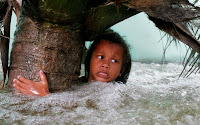

 MANILA, Philippines – A recent study carried out by the United Nations University ranks the Philippines as the world's third riskiest country, following Tonga and Vanuatu, Ma Antonia Yulo Loyzaga, executive director of the Manila Observatory said, adding that the ranking was based on country's coping capabilities.
MANILA, Philippines – A recent study carried out by the United Nations University ranks the Philippines as the world's third riskiest country, following Tonga and Vanuatu, Ma Antonia Yulo Loyzaga, executive director of the Manila Observatory said, adding that the ranking was based on country's coping capabilities. "All of these natural hazards are making us the prime laboratory for the study of disasters all over the world," Loyzaga told the Inquirer during a lecture on how to survive disasters, at Ateneo University in Rockwell Commercial Center
 In addition, a local paper said, some 50 million schoolchildren and 15 million coastal residents live in low-lying coastal areas; about 10 metres below sea-level and are exposed to earthquake hazards and rising sea levels, respectively; confirming Philippines one of the world's riskiest places,.
In addition, a local paper said, some 50 million schoolchildren and 15 million coastal residents live in low-lying coastal areas; about 10 metres below sea-level and are exposed to earthquake hazards and rising sea levels, respectively; confirming Philippines one of the world's riskiest places,. - A Columbia University study in 2007 also says that
 the 50 million Filipino school children at risk during quakes topped the number in India and China. This estimate had been made after a powerful earthquake hit Szechuan, China in May 2008.
the 50 million Filipino school children at risk during quakes topped the number in India and China. This estimate had been made after a powerful earthquake hit Szechuan, China in May 2008. - Furthermore, coastal areas are subsiding in the Philippines, putting residents of these areas and the
 entire country at risk in the event of tsunamis, Loyzaga quoted Columbia study's warning.
entire country at risk in the event of tsunamis, Loyzaga quoted Columbia study's warning. - "This will give us an indication of where we must be most careful as far as protecting our students. Therefore the Department of Education in the Philippines must look at the places where schools are built, and find out if they are sitting on fault lines,” Loyzaga said..
 Loyzaga also cited studies done by the Manila Observatory which showed the Philippines is "getting hotter and this has implications on the country's food security".
Loyzaga also cited studies done by the Manila Observatory which showed the Philippines is "getting hotter and this has implications on the country's food security".A one degree change in minimum temperature will lead to a 10 per cent decrease in rice yields, according to studies by the International Rice Research Institute, Loyzaga said.




















Post a Comment